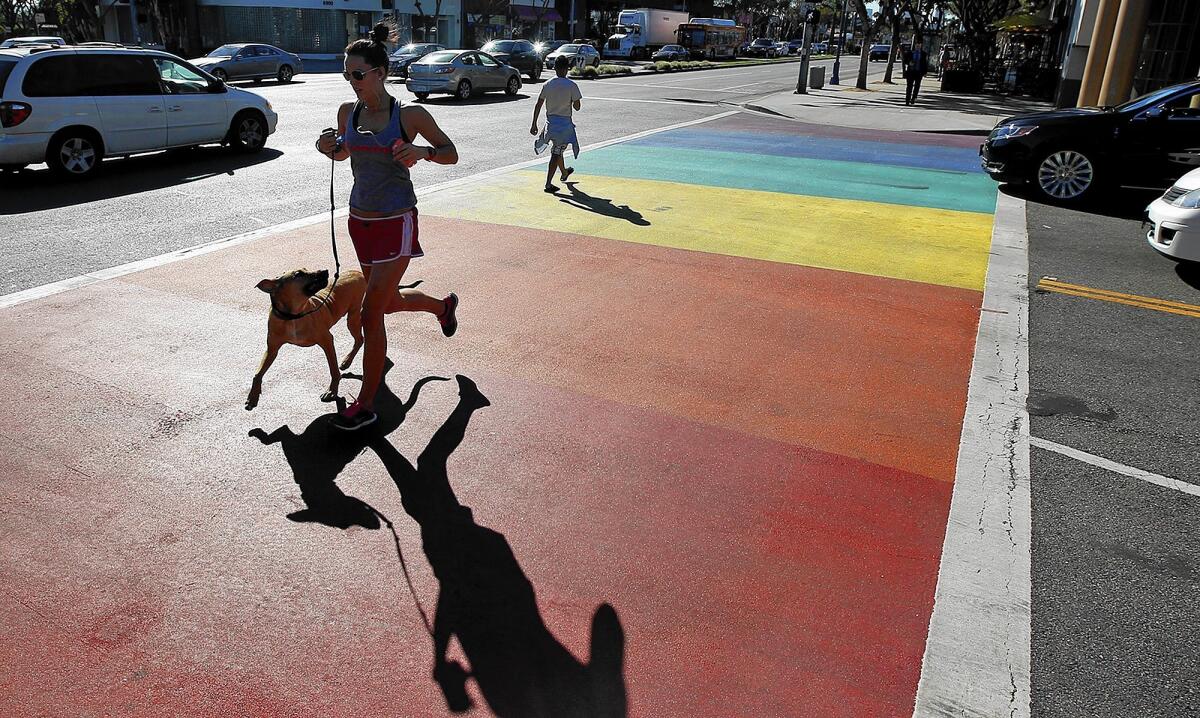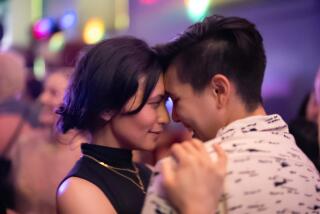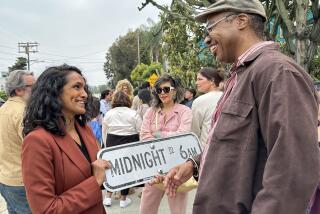West Hollywood’s increasing diversity inspires mixed emotions

- Share via
Councilman John Duran and his gay colleagues on the West Hollywood City Council never expected a backlash when they voted recently to remove the rainbow flag from above City Hall.
For Duran, who is gay, taking down the flag wasn’t about slighting gays but sending a message about the city’s diversity.
“It’s not just a city of gay men. It belongs to heterosexual people as well,” he said.
But the flag’s removal in a place synonymous with gay life outraged many, and the city this week changed course, raising above City Hall a flag with a rainbow-colored city logo.
The dust-up underscores a larger identity crisis facing the city once known as a “Gay Camelot.” When it was founded in 1984, West Hollywood was an oasis for gays, a place where they could be better protected from gay-bashing, find support during the AIDS crisis and fight discrimination.
But both West Hollywood and the rest of society have changed since those days. Gays now feel greater acceptance outside the boundaries of gay neighborhoods.
At the same time, West Hollywood has seen a development boom that has made the city a more hip, but not necessarily more gay, address. While the city’s gay population has remained at about 40% for some time, the commercial scene is changing. The city’s last lesbian bar, The Palms, was razed last year because the property owners wanted to develop the site, where an upscale supermarket has been proposed.
“The shedding of the LGBT identity is happening slowly with development [and] straight business owners,” said resident Larry Block. “There’s just a changing environment in West Hollywood.”
Block pushed to have the city fly the gay pride flag — raised in June to mark Pride Month and the legalization of gay marriage in California — year-round. He was a vocal critic when it was taken down.
Another flashpoint is the strip of gay bars along Santa Monica Boulevard. Some residents and merchants wanted to officially designate the area — the site of numerous gay rights protests and AIDS vigils — as “Boystown,” long a colloquial reference to the nightlife scene there. But city leaders balked at the idea, saying they felt the name was too narrow.
“Boystown failed … because the lesbian community, the female community and people who are not LGBT felt excluded, which is understandable,” said Robert Gamboa, co-chair of the city’s Lesbian and Gay Advisory Board.
There also has been much debate about the annual L.A. Pride celebration, when Santa Monica Boulevard is taken over by rainbow-colored floats and wild costumes. The parade started as a political statement about gay pride and unity. But these days, there are complaints that the parade has become more about corporate sponsorship and partying than about the civil rights message.
::
West Hollywood grabbed headlines around the world when it was incorporated, with activists declaring it “America’s first gay city.”
One of the first acts of its City Council, the first in the nation with a gay majority, was an ordinance banning discrimination against homosexuals. The city’s first mayor, a lesbian, personally removed the infamous sign in the tavern Barney’s Beanery that read “Fagots Stay Out.”
“When we first became a city, there were only a handful of gay and lesbian elected officials in the world,” said John Heilman, who has been on the City Council since incorporation. “The idea that there was a community that was embracing the LGBT community, that was something very novel.”
Councilman Duran moved to West Hollywood in 1990 after his Anaheim law firm, known for handling gay rights cases, had a swastika sticker slapped on its business sign with the words “Trash ‘em, Smash’em, Make’em Die.” He and his colleagues kept a thick file of hate mail, and the back porch of his Santa Ana home was set on fire. Even in West Hollywood, he had gay slurs screamed at him and rocks and bottles thrown from cars passing on Santa Monica Boulevard.
“It was a very different time,” he said. “Today we rarely see hate crimes in West Hollywood.”
Back then, the city was losing scores of young men to the AIDS epidemic. The young city government turned its attention to battling the disease and it was one of the first cities in the nation to create an AIDS educational campaign.
Duran says West Hollywood, which turns 30 this year, has matured along with the gay experience and become more diverse. There’s still the wild bar scene, but now gay residents can also get married and raise kids in the city.
“You can still have some of the craziness of what West Hollywood was always about, the late-night parties and good times on Santa Monica Boulevard,” he said. “You can still wear drag or leather yourself out, but you can also marry somebody and have children or you can serve as a Marine.”
The same transition is underway in other historic gay districts like the Castro in San Francisco, Chelsea in New York and Washington, D.C.’s Dupont Circle.
Gary Gates, a researcher at UCLA’s Williams Institute, which studies LGBT demographics, said people are more comfortable being out of the closet wherever they live, even outside gay neighborhoods. And with the Internet they can find friends anywhere.
A survey of LGBT Americans last year found they were split on how much they should assimilate into the broader culture. Of the adults surveyed by the Pew Research Center, 49% said they should pursue equality while maintaining a distinct culture; 49% said they should “become part of mainstream culture and institutions like marriage.”
There also was a split over LGBT bars and neighborhoods, with 56% saying it was important to maintain them and 41% saying they will become less essential.
West Hollywood officials say they have no intention of shying away from the city’s gay history. There are rainbow-colored crosswalks on Santa Monica Boulevard and rainbow flags in traffic medians.
Local businesses have drawn widespread attention for taking political stands on LGBT issues. In February, gay bar The Abbey banned “every legislator in any state that votes for bills to allow for discrimination against LGBT people” and gave such legislators’ head shots to security guards.
Still, some say the city should be doing more for gay rights.
In other countries, “simply being gay is illegal,” resident Dan Berkowitz said a council meeting. “Flying the rainbow flag over West Hollywood, you are saying that West Hollywood as a city welcomes you. Not just our shops, not just our bars and restaurants, but the city.”
Gregg Collins, who called himself a “happy, gay, married West Hollywood homeowner,” said both gay people and straight friends visit for “our huge varieties of gay-themed entertainment,” including drag shows, go-go dancers and dance parties. Collins runs a guide to the city’s social life called Gay West Hollywood and has heard some gay people complain that there are too many straight people in gay venues.
“I tell them, if we are fighting for gay equality,” he said, “how can we be hypocrites and complain about it once it happens?”
More to Read
Sign up for Essential California
The most important California stories and recommendations in your inbox every morning.
You may occasionally receive promotional content from the Los Angeles Times.











